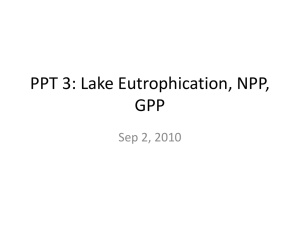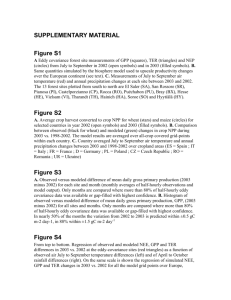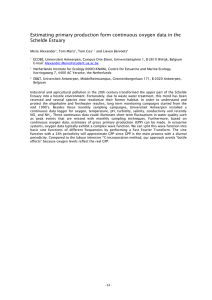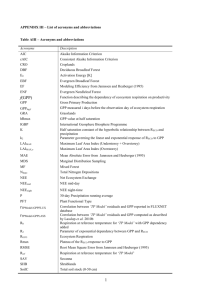Analysis of the spatial and temporal variability of savanna productivity... Northern Territory, Australia using MODIS data
advertisement
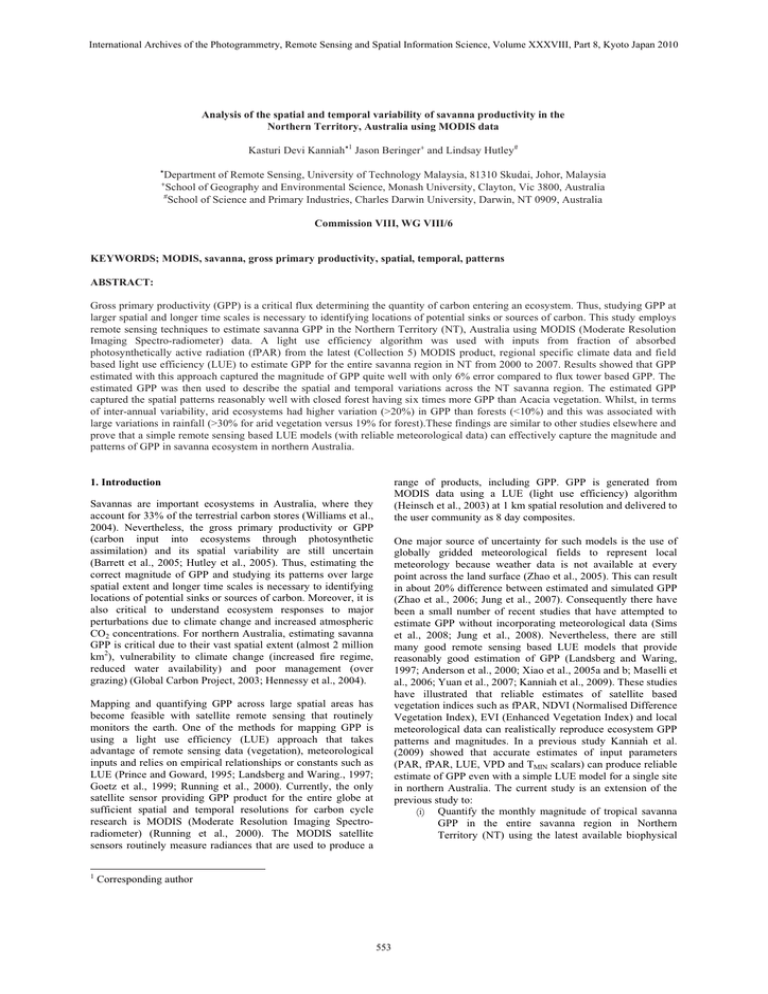
International Archives of the Photogrammetry, Remote Sensing and Spatial Information Science, Volume XXXVIII, Part 8, Kyoto Japan 2010 Analysis of the spatial and temporal variability of savanna productivity in the Northern Territory, Australia using MODIS data Kasturi Devi Kanniah 1 Jason Beringer and Lindsay Hutley Department of Remote Sensing, University of Technology Malaysia, 81310 Skudai, Johor, Malaysia School of Geography and Environmental Science, Monash University, Clayton, Vic 3800, Australia School of Science and Primary Industries, Charles Darwin University, Darwin, NT 0909, Australia Commission VIII, WG VIII/6 KEYWORDS; MODIS, savanna, gross primary productivity, spatial, temporal, patterns ABSTRACT: Gross primary productivity (GPP) is a critical flux determining the quantity of carbon entering an ecosystem. Thus, studying GPP at larger spatial and longer time scales is necessary to identifying locations of potential sinks or sources of carbon. This study employs remote sensing techniques to estimate savanna GPP in the Northern Territory (NT), Australia using MODIS (Moderate Resolution Imaging Spectro-radiometer) data. A light use efficiency algorithm was used with inputs from fraction of absorbed photosynthetically active radiation (fPAR) from the latest (Collection 5) MODIS product, regional specific climate data and field based light use efficiency (LUE) to estimate GPP for the entire savanna region in NT from 2000 to 2007. Results showed that GPP estimated with this approach captured the magnitude of GPP quite well with only 6% error compared to flux tower based GPP. The estimated GPP was then used to describe the spatial and temporal variations across the NT savanna region. The estimated GPP captured the spatial patterns reasonably well with closed forest having six times more GPP than Acacia vegetation. Whilst, in terms of inter-annual variability, arid ecosystems had higher variation (>20%) in GPP than forests (<10%) and this was associated with large variations in rainfall (>30% for arid vegetation versus 19% for forest).These findings are similar to other studies elsewhere and prove that a simple remote sensing based LUE models (with reliable meteorological data) can effectively capture the magnitude and patterns of GPP in savanna ecosystem in northern Australia. range of products, including GPP. GPP is generated from MODIS data using a LUE (light use efficiency) algorithm (Heinsch et al., 2003) at 1 km spatial resolution and delivered to the user community as 8 day composites. 1. Introduction Savannas are important ecosystems in Australia, where they account for 33% of the terrestrial carbon stores (Williams et al., 2004). Nevertheless, the gross primary productivity or GPP (carbon input into ecosystems through photosynthetic assimilation) and its spatial variability are still uncertain (Barrett et al., 2005; Hutley et al., 2005). Thus, estimating the correct magnitude of GPP and studying its patterns over large spatial extent and longer time scales is necessary to identifying locations of potential sinks or sources of carbon. Moreover, it is also critical to understand ecosystem responses to major perturbations due to climate change and increased atmospheric CO2 concentrations. For northern Australia, estimating savanna GPP is critical due to their vast spatial extent (almost 2 million km2), vulnerability to climate change (increased fire regime, reduced water availability) and poor management (over grazing) (Global Carbon Project, 2003; Hennessy et al., 2004). One major source of uncertainty for such models is the use of globally gridded meteorological fields to represent local meteorology because weather data is not available at every point across the land surface (Zhao et al., 2005). This can result in about 20% difference between estimated and simulated GPP (Zhao et al., 2006; Jung et al., 2007). Consequently there have been a small number of recent studies that have attempted to estimate GPP without incorporating meteorological data (Sims et al., 2008; Jung et al., 2008). Nevertheless, there are still many good remote sensing based LUE models that provide reasonably good estimation of GPP (Landsberg and Waring, 1997; Anderson et al., 2000; Xiao et al., 2005a and b; Maselli et al., 2006; Yuan et al., 2007; Kanniah et al., 2009). These studies have illustrated that reliable estimates of satellite based vegetation indices such as fPAR, NDVI (Normalised Difference Vegetation Index), EVI (Enhanced Vegetation Index) and local meteorological data can realistically reproduce ecosystem GPP patterns and magnitudes. In a previous study Kanniah et al. (2009) showed that accurate estimates of input parameters (PAR, fPAR, LUE, VPD and TMIN scalars) can produce reliable estimate of GPP even with a simple LUE model for a single site in northern Australia. The current study is an extension of the previous study to: (i) Quantify the monthly magnitude of tropical savanna GPP in the entire savanna region in Northern Territory (NT) using the latest available biophysical Mapping and quantifying GPP across large spatial areas has become feasible with satellite remote sensing that routinely monitors the earth. One of the methods for mapping GPP is using a light use efficiency (LUE) approach that takes advantage of remote sensing data (vegetation), meteorological inputs and relies on empirical relationships or constants such as LUE (Prince and Goward, 1995; Landsberg and Waring., 1997; Goetz et al., 1999; Running et al., 2000). Currently, the only satellite sensor providing GPP product for the entire globe at sufficient spatial and temporal resolutions for carbon cycle research is MODIS (Moderate Resolution Imaging Spectroradiometer) (Running et al., 2000). The MODIS satellite sensors routinely measure radiances that are used to produce a 1 Corresponding author 553 International Archives of the Photogrammetry, Remote Sensing and Spatial Information Science, Volume XXXVIII, Part 8, Kyoto Japan 2010 fPAR data (spatial resolution and temporal aggregation of 8 days). Daytime VPD was calculated in this study using equation provided in Jeffrey et al., (2001). These data were used together with a site specific savanna LUE (1.26 g C m-2 MJ PAR-1) (Kanniah et al., 2009) to estimate GPP for the entire NT savanna region. The datasets and overall methodology adopted to estimate GPP at the regional scale in the NT are shown in Figure 2. (fPAR) data from MODIS Collection 5, savanna LUE and regional specific meteorological data. (ii) Assess the accuracy of the estimated GPP (in (i) above) (a) with GPP measured by a flux tower in (Howard Springs) in Northern Territory and (b) by analysing its spatial and temporal patterns according to different vegetation types in the savanna region of the NT 2. Study region The Northern Territory (NT) is a federal territory of Australia; occupying much of the central northern regions. Savanna ecosystems in the NT cover ~47.8% (based on classification by Fox et al., 2001) of the NT’s land area and represent about 32.6% of the total savanna area (1.97 million km2) in Australia (Fox et al., 2001). Thus, savannas subside in areas of high spatial variation in climate, vegetation structure and composition, (Williams et al., 1996; Eagan and Williams, 1996) and possibly productivity. On a broader scale, savanna in the NT can be grouped into savanna open forest, savanna woodland, savanna grasslands, Acacia woodland and shrublands; based on the height of the tallest stratum and canopy projective cover (Specht and Specht, 2002). Other ecosystems such as monsoon rainforest, floodplains and riparian areas in small patches are also found within the vast matrix of savanna (Woinarski et al., 2007). Fox et al. (2001) classified savanna vegetation in northern Australia into 26 broad vegetation groups (BVG), of which, 19 BVG are found in the NT. Figure 1: Flow chart showing datasets and methodology adopted to estimate GPP (gross primary productivity) for the Northern Territory (NT) savanna region using a LUE (light use efficiency) algorithm. 3 Data and methodology 4. Results and Discussion A simple LUE model (Equation 1) formulated by Monteith, 1972 and modified by the MODIS land science team (Heinsch et al., 2003) was used in this study to estimate GPP for the NT savanna region as follows: 4.1 Validation of estimated GPP GPP estimated in this study were extracted at the Howard Springs flux tower site (single pixel of ~ 1 km2) and compared with tower derived GPP (Beringer et al., 2007). Results (Figure 2) show that GPP calculated using Equation (1) were not significantly different from tower GPP (t115,63 = 0.90, p= 0.37). This was also agreed by high index of agreement (IOA =0.93), low RMSE (0.80 g C m-2 day-1) and relative predictive error (RPE =-6.3%) values. Overall, GPP estimated in this study agreed well with tower derived GPP over annual time scales (an underestimation of only 6%). Seasonal analysis shows an underestimation of 12.1% in the wet season (IOA = 0.55 and RMSE of 1.02 g C m-2 day-1). In the dry season however, modelled GPP agreed well with tower GPP (IOA 0.95 and RMSE of 0.62 g C m-2 day-1) and only slightly overestimated with RPE of 1.4%. GPP (g C m-2 day-1) = APAR (MJ) x LUE (g C MJ-1) x TMIN scalar x VPD scalar (1) Where, APAR= total absorbed Photosynthetically Active solar Radiation (PAR) by plants and it is estimated as fPAR (fraction of PAR) x PAR)) LUE= maximum potential LUE of a particular vegetation type TMINscalar and VPDscalar = environmental constraints or stress (daily minimum temperature and daytime VPD) that can reduce the maximum LUE (LUE = maximum LUE x VPDscalar x TMINscalar). The scalars vary from 0 to 1. MODIS Collection 5 fPAR/LAI data (MOD15) from the Terra sensor were used in this study since it was validated against field data and showed an acceptable accuracy for savanna vegetation in northern Australia (Kanniah et al., 2009). The spatial resolution of these data is ~ 1 km (926.62 m) and is aggregated into 8 day composites. These images were downloaded from NASA (National Aeronautic and Space Administration) website and processed to include only savanna region in the NT and best quality pixels (fPAR that were derived by Main Radiative Transfer algorithm under cloudless conditions, QC = 0) (Myneni et al., 2002). Similarly, climate data (shortwave solar radiation, temperature and relative humidity) were obtained from SILO and processed to match GPP estimated in this study could not be validated at other sites in the NT due to an unavailability of field data. However, analysis of the temporal variation provides plausible patterns, with higher values in the wet and lower values in the dry seasons. The magnitude of GPP also reduced with decreasing rainfall along the the Northern Australian Tropical Transect (NATT) (data not shown). 554 International Archives of the Photogrammetry, Remote Sensing and Spatial Information Science, Volume XXXVIII, Part 8, Kyoto Japan 2010 a model to estimate GPP for the conterminous U.S.A. Validation of their results using flux tower derived GPP (annual total GPP) covering various vegetation types provided an overall relative error (annual total tower GPP – annual total modelled GPP/annual total tower GPP u 100) of 22% for forested ecosystems and 32% for non forested ecosystems such as grasslands, savanna and crops. In this study, the relative error between modelled and tower derived average annual total GPP (2001-2005) is only 6%. Yuan et al. (2007) also estimated GPP for the USA using a simple LUE model with regional specific meteorological data. They used minimum temperature (TMIN) and evaporative fraction to constrain the maximum LUE (different from this study which used TMIN and VPD to down-regulate the maximum LUE). Validation of their results at various Ameriflux sites showed RPE (mean modelled daily average GPP- mean tower GPP/mean tower GPP) ranging between 0 and 44% for forested ecosystems and 10 to 41% for grassland and savanna. In this study, the RPE for monthly average GPP for one savanna site is lower with 6.3%, but may be spatially more variable. Figure 2: Validation of estimated and tower derived GPP (gross primary productivity) at Howard Springs flux tower site. GPP are shown as monthly average values r SE from 2001 to 2006 (periods of available data from model and tower data). Average annual total GPP for Howard Springs from 2001-2005 (periods of available annual tower GPP) indicated that the estimated GPP using fPAR Collection 5 and SILO meteorology was 1314 ± 15 g C m-2 year-1( mean ± Standard Error). Months with missing GPP (January, February and December), were replaced by multiyear averages of the same month. Annual mean GPP obtained from this study was ~86 g C or 6% lower than flux tower GPP (~1400 g C m-2 year-1) for the same period of study (Beringer et al., 2007). GPP estimated from this study was closer to the estimates from flux tower than any other estimates for the same location. For example, Roderick et al. (2001) and Berry and Roderick (unpublished data, Berry personal communication) modelled ~1940 and 2219 g C m-2 year-1, respectively using different methods. Roderick et al. (2001) used a LUE model to calculate GPP using fPAR (estimated from AVHRR NDVI), but did not incorporate the impact of water limitation explicitly, although they note that this effect may be important. As a result, GPP was overestimated, especially in water limited regions such as in the central arid regions and savannas. Similarly, Berry and Roderick (unpublished data) also overestimated GPP, despite using high temporal resolution MODIS data (250 meter) to derive fPAR, and incorporated sunlit and shaded leave scheme to estimate GPP for the continent of Australia. Chen et al. (2003) provided GPP of 2080 g C m-2 year-1 using biomass sampling at this site. Clearly, more field data over large spatial extents is needed in northern Australian savannas to validate the different GPP models. Since the use of regional gridded meteorological data can introduce errors of up to 20% between simulated and measured GPP (Jung et al., 2007), new techniques were introduced to estimate GPP by minimising the use of meteorological data (Sims et al., 2006, 2008). Sims et al. (2008) for example, estimated GPP based on a simple relationship between EVI, land surface temperature (MODIS) and GPP, which improved the prediction of GPP for several evergreen needle leaf and deciduous broadleaf forests in North America. Although this new method improved the correlation coefficient (r2) between tower and modelled GPP over these sites (r2 ranging between 0.69 and 0.94), over the Tonzi Ranch savanna site, the strength of the correlation between modelled and tower GPP (16 day composites) was only moderate (r2 0.48) compared to a r2 value of 0.83 in this study. Next, we assessed the accuracy of GPP estimated in this study by analysing the spatial and temporal patterns of GPP for different vegetation types in the NT . The results are described in the following section. 4.2 Spatial and temporal patterns of GPP Regional GPP was analysed in this study based on a vegetation map produced by Fox et al. (2001) for the savanna region of northern Australia. GPP was examined spatially across the entire savanna region of the NT from the coast to the southern savanna boundary (Figure 3). Average GPP for different Broad Vegetation Groups (BVG) were calculated and compared with each other. The 19 BVG found in the NT were regrouped into 8 subgroups (Figure 3) based on either structural (height and foliage projective cover of the tallest stratum) or plant functional types (Fox et al., 2001; Spessa et al., 2005). Regrouping was done to simplify the interpretation of the results. The reason for the close agreement between GPP estimated in this study and tower estimated values may be due to the counteracting effects between the input variables. This study overestimated annual PAR and fPAR by 2% and 7%, respectively, whereas the daytime VPD scalar was underestimated by RPE of 17% (data not shown). As a consequence of the counteracting effects, estimated GPP matches the tower derived GPP. These results are consistent with suggestions made by several researchers (Zhao et al., 2006; Sims et al., 2006, 2008; Jung et al., 2008) that meteorological data can be a major source of error in estimating regional GPP. Consequently, new techniques that vary in complexity to improve the estimation of GPP at a single flux tower site or regional scales have been proposed (Maselli et al., 2006; Sims et al., 2006, 2008; Coops et al., 2007; Li et al., 2007; Yuan et al., 2007; Zhang et al., 2007; Jung et al., 2008). Yang et al. (2007) for example used a support vector machine approach, which combined tower based GPP, land surface temperature, EVI, radiation and land cover information to train Monthly GPP, fPAR, rainfall, radiation, temperature and daytime VPD data for each of the 19 BVG classes were extracted using the zonal statistics function available in ARCGIS software. The vegetation map of Fox et al., (2001) was first converted from vector into raster and the cell size was resampled to 926.62 m resolution to match the fPAR, GPP and climate data. 555 International Archives of the Photogrammetry, Remote Sensing and Spatial Information Science, Volume XXXVIII, Part 8, Kyoto Japan 2010 in Africa. In agreement with Merbold, Cias et al. (2008) also found that rainfall explained only 6-7% variation in GPP in forest ecosystems compared to 42 to 77% in savannas in Africa. Yang et al. (2008) also found a slight reduction in global grassland ANPP (above ground net primary productivity) under humid environments (mean annual rainfall > 1035 mm). Meanwhile, the rest of the vegetation classes (Table 2) exhibits a strong linear relationship (r2 values ranging between 0.67 and 0.80) and significant correlation (p<0.05) between GPP and rainfall. The slope of the relationship between rainfall and GPP is relatively higher ( 0.20) for vegetation that grows in much drier environment such as grassland, Acacia, low woodlands and low open woodlands compared to woodlands and open forest (slope of 0.13). Similar findings were also obtained by Cias et al. (2008) where the slope of the GPP versus rainfall regression is ~ 50% lower for forest than for savanna in Africa. These results show that for arid and semi arid regions, the variability in GPP is highly dependent on the onset of rainfall. The spatial statistics were used to describe the differences in the spatial variation in GPP, fPAR, and climate for each of the 19 BVG’s found in the savanna region of the NT. Relationships between these environmental drivers and GPP were determined to find the major control on savanna GPP. Inter-annual variability in GPP among different vegetation groups was also examined with these datasets. Monthly GPP extracted for each of the 8 BVG shows that on average, closed forest had the largest GPP, followed by open forest, woodlands, low woodlands, riparian vegetation, low open woodlands, grassland, and Acacia woodland and shrublands. The difference in GPP among the 8 classes is statistically significant (one- way ANOVA F7,1751 = 343.72, p<0.001). GPP across the 8 savanna vegetation classes generally increase with canopy cover and/ or vegetation height, which is also reflected in rainfall (Table 1). On a sub continental scale, closed forest (1114.65 g C m-2 year-1) had about 4 and 6 times higher GPP than grassland and Acacia (woodlands and shrublands), respectively (Figure 4). Table 1. Regrouped vegetation classes and their corresponding structural characteristics (height and foliage projective cover), broad vegetation groups (BVG) and spatial extent in the Northern Territory (sources: Fox et al., 2001; Specht and Specht 2002; Australian Natural Resources Atlas (http://www.anra.gov.au). Regrouped BVG Closed forest Open forest Woodlands Low Woodlands Low Open Woodlands Grassland Acacia woodlands & shrublands Riparian Figure 3. Spatial distribution of vegetation types in the savanna region of Northern Territory, Australia that were aggregated into 8 structural/functional classes (Source: Fox et al., 2001). The inter-annual variability in GPP for different vegetation types (regrouped 8 BVG) and its dependency on rainfall was also examined in this study. The coefficient of variation (CV) value of GPP for these eight BVG showed a large inter-annual variation for arid ecosystems such as grassland and Acacia (>20%), whereas GPP in forest (close and open), woodlands and low woodlands were less variable (<10%). Riparian and low open woodland had intermediate variation with CV, ranging between 13 and 14%. These results support other findings that inter annual variability in grasslands’ above net primary productivity and net primary productivity is high (Knapp and Smith, 2001; Fang et al., 2001; Yang et al., 2008). Height of tallest stratum 10-30 m 10-30 m 10-30 m 5-10 m 5-10 m Foliage projective cover 70-100% 10-70% <10-30% 10-30% <10% 1550 r 103 1102 r 89 1049r 82 977 r 75 766 r 70 <10 m various - 657 r 73 444 r 66 - - 893 r 89 Annual Rainfall (mm) r SE Figure 4. Mean annual GPP (gross primary productivity) of regrouped 8 structural/functional savanna classes as classified by Fox et al. (2001). Error bars represent the Standard Error of the mean. CF= closed forest, OF= open forest, W= woodlands, LW= low woodlands and LOW= low open woodlands. The relationship between annual GPP and rainfall for closed forest is best described by a polynomial fit (r2 = 0.74 and p = 0.30), which indicates higher rainfall (> 1500mm) can reduce GPP (Table 2). This may be resulted from frequent cloud cover in the wet season in this monsoonal environment that may inhibit plant growth by decreasing solar radiation. This finding is similar to that of Merbold et al. (2008) who found that radiation was limiting GPP, and not rainfall, in the inner tropics 556 International Archives of the Photogrammetry, Remote Sensing and Spatial Information Science, Volume XXXVIII, Part 8, Kyoto Japan 2010 ecosystem productivity in North Australia. Global Change Biology, 13, 990-1004. Chen, X., Hutley, L. B. and Eamus, D., 2003, Carbon balance of a tropical savanna of northern Australia. Ecosystem Ecology, 137, 405-416. Ciais, P., S.-L. Piao, Cadule, P., Friedlingstein, P. and Chedin, A., 2008. Variability and recent trends in the African carbon balance. Biogeosciences Discussion, 5, 34973532. Coops, N. C., Black, T. A., Jassal, R. S., Trofymow, J. A. and Morgenstern, K., 2007, Comparison of MODIS, eddy covariance determined and physiologically modelled gross primary production (GPP) in a Douglas-fir stand. Remote Sensing of Environment, 107, 385-401. Fang, J. Y., Piao, S. L., Tang, Z. Y., Peng, C. H. and Ji, W., 2001. Interannual variability in net primary production and precipitation. Science, 293, 1723. Fox, I. D., Nelder, V. J., Wilson, G. W. and Bannink, P. J. 2001. The vegetation of the Australian tropical savannas, Environmental Protection Agency, Brisbane, Queensland. Global Carbon Project., 2003. Science Framework and Implementation. Earth System Science Partnership (IGBP,IHDP,WCRP,DIVERSITAS) Report No. 1, Global Carbon Project Report No. 1, 587, 69pp, Canberra. Goetz, S. J., Prince, S. D., Goward, S. N., Thawley, M. M. and Small, J., 1999. Satellite remote sensing of primary production: an improved production efficiency modelling approach. Ecological Modelling, 122, 239255. Heinsch, F. A., Reeves, M., Votava, P., Kang, S., Milesi, C., Zhao, M., Glassy, J., Jolly, W. M., Loehman, R., Bowker, C. F., Kimball, J. S., Nemani, R. R. and Running, S. W., 2003. User's guide: GPP and NPP (MOD17A2/A3) products, NASA MODIS land algorithm, version 2.0, http://www.ntsg.umt.edu/modis/MOD17UsersGuide.p df (accessed 24 Dec.2008) Hennessy, K., Page, C., Mcinnes, K., Walsh, K., Pittock, B., Bathols, J. and Suppiah, R. 2004. Climate change in the Northern Territory. Northern Territory Government, Darwin. http://www.dar.csiro.au/publications/hennessy_2004a .pdf (accessed 24 Dec.2008) Hutley, L. B., Leuning, R., Beringer, J. and Cleugh., 2005. The utility of the eddy covariance techniques as a tool in carbon accounting: tropical savanna as a case study. Australian Journal of Botany, 53, 663-675. Jeffrey, S. J., Carter, J. O., Moodie, K. B. and Beswick, A. R., 2001. Using spatial interpolation to construct a comprehensive archive of Australian climate data. Environmental Modelling & Software, 16, 309 - 330. Jung, M., Verstraete, M., Gobron, N., Reichstein, M., Papale, D., Bondeau, A., Robustelli, M. and Pinty, B., 2008. Diagnostic assessment of European Gross Primary Production. Global Change Biology, 14, 2349–2364. Jung, M., Vetter, M., Herold, M., Churkina, G., Reichstein, M., Zaehle, S., Ciais, P., Viovy, N., Bondeau, A., Chen, Y., Trusilova, K., Feser, F. and Heinmann, M., 2007. Uncertainties of modeling gross primary productivity over Europe: A systematic study on the effects of using different drivers and terrestrial biosphere models. Global Biogeochemical Cycles, 21, GB4021. Kanniah, K. D., Beringer, J., Hutley, L. B., Tapper, N. J. & Zhu, X. 2009. Evaluation of Collections 4 and 5 of Table 2. Relationship between annual GPP and rainfall (R) for different vegetation types within the savanna region of Northern Territory. CF= closed forest, OF= open forest, W= woodlands, LW= low woodlands and LOW= low open woodlands. The strength and significance of the relationship are shown by R2 (coefficient of determination) and P values respectively. Regrouped BVG CF Relationship between GPP and rainfall (R) GPP = 0.0005*R + 1.5009*R P value 0.3017 + 130.55 (R2 = 0.74) OF GPP = 683.35 + 0.13*R ((R2 = 0.59) 0.0253 W GPP = 560.44 + 0.10*R (R2 = 0.67) 0.0134 LW GPP = 396.49 + 0.14*R (R2 = 0.78) 0.0034 LOW GPP = 190.76 + 0.20*R (R2 = 0.79) 0.0030 Grass GPP = 63.74 + 0.24*R (R2 = 0.80) 0.0026 2 Acacia GPP = 86.08 + 0.20*R (R = 0.78) 0.0049 Riparian GPP = 278.27 + 0.22*R (R2 = 0.72) 0.0081 5. Conclusion In this study, an attempt was made to estimate GPP for savannas of the NT for a period of 8 years. The latest available fPAR data from MODIS Collection 5, meteorological data provided by the Department of Natural Resources and Water Resources, Queensland and light use efficiency (LUE) calculated using flux tower data at Howard Springs were used to estimate GPP. This study proves that a simple remote sensing based model with reliable local meteorological data can provide reasonably good estimates of GPP (only 6% error compared to ground data). The estimated GPP was also found to describe the spatial and temporal patterns of GPP across the savanna region in NT reasonable well. Thus, it can be concluded that knowledge of the biophysical processes and analytical tools such as remote sensing can be integrated into a complex social and economic framework to achieve ecologically sustainable development in tropical savannas. 6. References Anderson, M. C., Norman, J. M., Meyers, T. P. and Diak, G. R., 2000. An analytical model for estimating canopy transpiration and carbon assimilation fluxes based on canopy light-use efficiency. Agricultural and Forest Meteorology, 101, 265-289. Barrett, D. J., Hill, M. J., Hutley, L. B., Beringer, J., Xu, J. H., Cook, G. D., Carter, J. O. and Williams, R. J., 2005. Prospects for improving savanna biophysical models using multiple- constraints model data assimilation methods. Australian Journal of Botany, 53, 689-714. Beringer, J., Hutley, L. B., Tapper, N. J. and Cernusak, L. A., 2007. Savanna fires and their impact on net 557 International Archives of the Photogrammetry, Remote Sensing and Spatial Information Science, Volume XXXVIII, Part 8, Kyoto Japan 2010 uncertainties and potential impacts of fire. Functional Plant Biology, 31, 415-422. Woinarski, J., Mackey, B., Nix, H. and Traill, B., 2007. The Nature of Northern Australia Its natural values, ecological processes and future prospects, ANU ePress, 127pp. Xiao, X., Hollinger, D., Aber, J., Goltz, M., Davidson, E. A., Zhang, Q. and Moore Iii, B., 2005. Satellite based modeling of gross primary production in an evergreen needleleaf forest. Remote Sensing of Environment, 89, 519-534. Xiao, X., Zhang, Q., Saleska, S., Hutyra, L., Camargo, P. D., Wofsy, S., Frolking, S., Boles, S., Keller, M. and Moore Iii, B., 2005. Satellite based modelling of gross primary production in a seasonally moist tropical evergreen forest. Remote Sensing of Environment, 94, 105-122. Yang, F., Ichii, K., White, M., A, Hashimoto, H., Michaelis, A. R., Votava, P., Zhu, A.-X., Huete, A., Running, S. W. and Nemani, R. R., 2007. Developing a continentalscale measure of gross primary production by combining MODIS and AmeriFlux data through Support Vector Machine approach. Remote Sensing of Environment, 110, 109-122. Yang, Y., Fang, J., Ma, W. and Wang, W., 2008. Relationship between variability in aboveground net primary production and precipitation in global grasslands. Geophysical Research Letters, 35, L23710, doi:23710.21029/22008GL035408. Yuan, W., Liu, S., Zhou, G., Zhou, G., Tieszen, L. L., Baldocchi, D., Bernhofer, C., Gholz, H., Goldstein, A. H., Goulden, M. L., Hollinger, D. Y., Hu, Y., Law, B. E., Stoy, P. C., Vesala, T., Wofsy, S. C. and Al, E., 2007. Deriving a light use efficiency model from eddy covariance flux data for predicting daily gross primary production across biomes. Agricultural and Forest Meteorology, 143, 189-207. Zhang, L., Wylie, B., Loveland, T., Fosnight, E., Tieszen, L. L. and Gilmanov, T., 2007. Evaluation and comparison of gross primary production estimates for the Northern Great Plains grasslands. Remote Sensing of Environment, 106, 173-189. Zhao, M., Heinsch, F. A., Nemani, R. R. and Running, S. V., 2005. Improvements of the MODIS terrestrial gross and net primary production global data set. Remote Sensing of Environment, 95, 164-176. Zhao, M., Running, S. W. and Nemani, R. R., 2006. Sensitivity of Moderate Resolution Imaging Spectroradiometer (MODIS) terrestrial primary production to the accuracy of meteorological reanalyses. Journal of Geophysical Research, 111, doi:10.1029/2004JG000004. the MODIS Gross Primary Productivity product and algorithm improvement at a tropical savanna site in northern Australia. Remote Sensing of Environment, 113, 1808-1822. Knapp, A. K. and Smith, M. D., 2001. Variation among biomes in temporal dynamics of aboveground primary production. Science, 291, 481– 484. Landsberg, J. J. and Waring, R. H., 1997. A generalized model of forest productivity using simplified concepts of radiation use efficiency, carbon balance and partitioning. Forest Ecology and Management, 95, 209–228. Merbold, L., Ard¨O, J., Arneth, A., Scholes, R. J., Nouvellon, Y, De Grandcourt, A., Archibald, S., Bonnefond, J. M., Boulain, N., Bruemmer, C., Brueggemann, N., Cappelaere, B., Ceschia, E., El-Khidir, H. A. M., ElTahir, B. A., Falk, U., Lloyd, J., Kergoat, L., Le Dantec, V., Mougin, E., Muchinda, M., Mukelabai, M. M., Ramier, D., Roupsard, O., Timouk, F., Veenendaal, E. M. and Kutsch, W. L., 2008. Precipitation as driver of carbon fluxes in 11 African ecosystems. Biogeosciences Discussion, 5, 40714105. Monteith, J. L., 1972. Solar radiation and productivity in tropical ecosystems. Journal of Applied Ecology, 9, 747–766. Myneni, R. B., Knyazikhin, Y., Privette, J. L. and Glassy, J., 2002. Global products of vegetation leaf area and fraction absorbed PAR from year one of MODIS data. Remote Sensing of the Environment, 83, 214-231. Prince, S. D. and Goward, S. N., 1995. Global primary production: A remote sensing approach. Journal of Biogeography, 22, 815-835. Roderick, M. L., Farquhar, G. D., Berry, S. L. and I.R, N., 2001. On the direct effect of clouds and atmospheric particles on the productivity and structure of vegetation, Oecologia, 129, 21-30. Running, S. W., Thornton, P. E., Nemani, R. R. and Glassy, J. M. 2000. Global terrestrial gross and net primary productivity from the earth observing system. IN Sala, O. E., Jackson, R. B., Mooney, H. A. and Howarth, R. W. (Eds.) Methods in Ecosystem Science. Springer-Verlag, New York, 44-57pp. Sims, D. A., Rahman, A. F., Cordova, V. D., El-Masri, B. Z., Baldocchi, D. D., Bolstad, P. V., Flanagan, L. B., Goldstein, A. H., Hollinger, D. Y., Misson, L., Monson, R. K., Oechel, W. C., Schmid, H. P., C, W. S. and Xu, L., 2008. A new model of gross primary productivity for North American ecosystems based solely on the enhanced vegetation index and land surface temperature from MODIS. Remote Sensing of Environment, 112, 1633-1646. Specht, R. L. and Specht, A., 2002. Australian Plant Communities Dynamics of structure, growth and biodiversity, Oxford University Press, South Melbourne, 492pp. Williams, R. J., Duff, G. A., Bowman, D. M. J. S. and Cook, G. D., 1996. Variation in the composition and structure of tropical savannas as a function of rainfall and soil texture along a large scale climatic gradient in the Northern Territory, Australia. Journal of Biogeography, 24, 747-756. Williams, R. J., Hutley, L. B., Cook, G. D., Russell-Smith, J., Edwards, A. and Chen, X., 2004. Assessing the carbon sequestration potential of mesic savanna in the Northern Territory, Australia: approaches, 558
